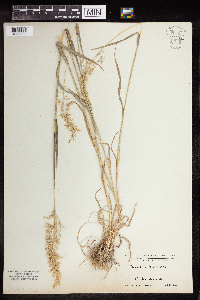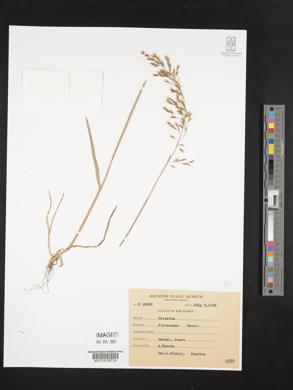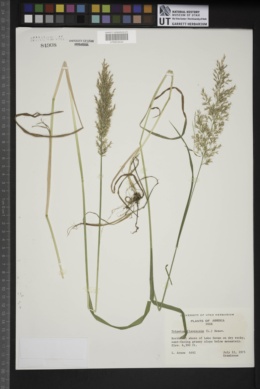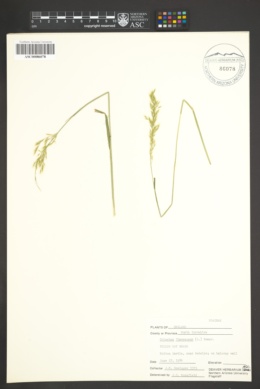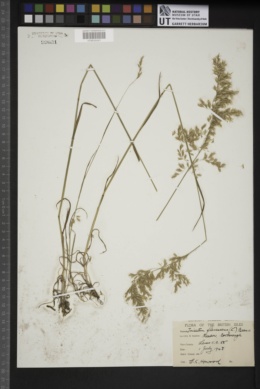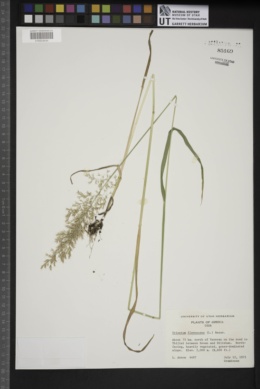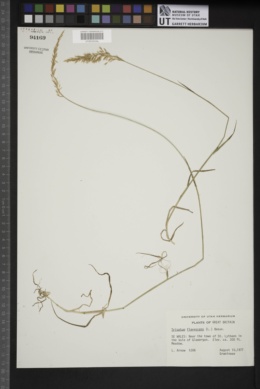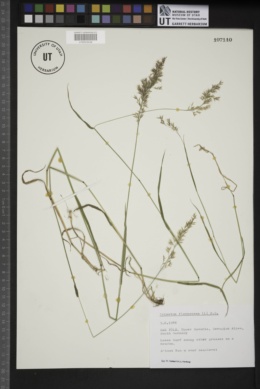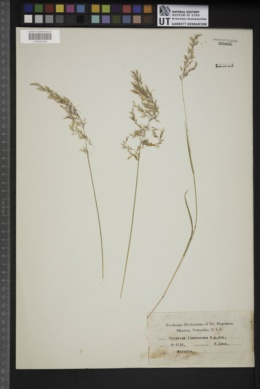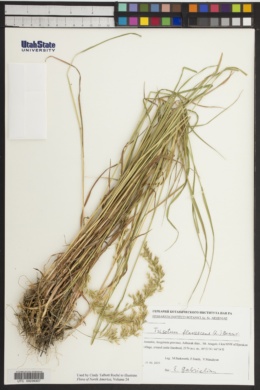Trisetum flavescens
|
|
|
|
Family: Poaceae
Yellow False Oat, more...Avoine Jaunâtre, Yellow Oatgrass
[Trisetaria flavescens (L.) Baumg., moreTrisetum pratense Pers.] |
Plants perennial, sometimes with both fertile and sterile shoots; usually cespitose, sometimes rhizomatous, rhizomes usually short, to 7 cm in sandy soils. Culms(10)50-80(130) cm, erect or decumbent, glabrous, sometimes scabrous or pubescent near the upper nodes. Leaves usually evenly distributed; sheaths glabrous or pilose, throats often with 2+ mm hairs; ligules 0.5-1(2) mm, obtuse, lacerate, sometimes ciliolate, with hairs to 0.5 mm; blades 5-15(18) cm long, 1.5-4(6) mm wide, flat or involute, lax, pubescent or pilose. Panicles 5-20 cm long, 1.5-7 cm wide, erect or nodding, glistening yellowish-brown, sometimes purple-tinged or variegated; branches 2-4(6) cm, ascending to divergent, often flexuous, sometimes naked below. Spikelets 4-8 mm, subsessile or on pedicels to 5 mm, with (2)3(4) florets; rachilla internodes to 1 mm or longer; rachilla hairs to 1.5 mm; disarticulation above the glumes and between the florets. Glumes unequal, shiny; lower glumes 2.5-4.7 mm, narrowly lanceolate to subulate; upper glumes 4-7 mm long, equaling or longer than the lowest florets, twice as wide as the lower glumes, lance-elliptic, acute; callus hairs to 0.5 mm; lemmas 3.5-6.3 mm, ovate-lanceolate, minutely pubescent, bifid or bicuspidate, teeth extended into conspicous, usually 3-6 mm bristles, awned, awns (3)5-9 mm, arising from the upper 1/3 of the lemmas, geniculate, tightly twisted below; paleas 3-5.5 mm; anthers 1.3-2.8 mm. Caryopses to 2.5-3 mm, glabrous. 2n = 28. Trisetum flavescens grows in seeded pastures, roadsides, and as a weed in croplands. Native to Europe, west Asia, and north Africa, it was introduced into the Flora region because of its drought resistance, wide soil tolerance, and high palatability to domestic livestock. It is one of the few range plants known to contain calcinogenic glycosides, which can lead to vitamin D toxicity in grazing animals (Dixon 1995). This species seems not to have persisted in southern Ontario (Michael Oldham, pers. comm.). Several infraspecific taxa have been recognized; no attempt has been made to determine which are present in the Flora region. Culms loosely tufted, 3-8 dm, glabrous, or hairy at the nodes; basal sheaths ±hairy, the others glabrous, main blades 2-6 mm wide; infl shining, 8-15 cm, narrow, rather dense but hardly spike-like; spikelets 5-7.5 mm, 2-4-fld; first glume 3-4 mm, subulate or lance- subulate, tapering from near the base to the tip, 1-veined; second glume much wider, 3-veined, 5-6 mm; rachilla and callus with hairs 1 mm; lemmas bifid; awn 4.5-6.5 mm, inserted 2 mm below the lemma-tip; anthers 1.5-2.5 mm; 2n=28. Native of Europe, intr. in waste places and along roads from Vt. to Mass. and N.Y., and occasionally elsewhere in our range. Gleason, Henry A. & Cronquist, Arthur J. 1991. Manual of vascular plants of northeastern United States and adjacent Canada. lxxv + 910 pp. ©The New York Botanical Garden. All rights reserved. Used by permission. |




















































